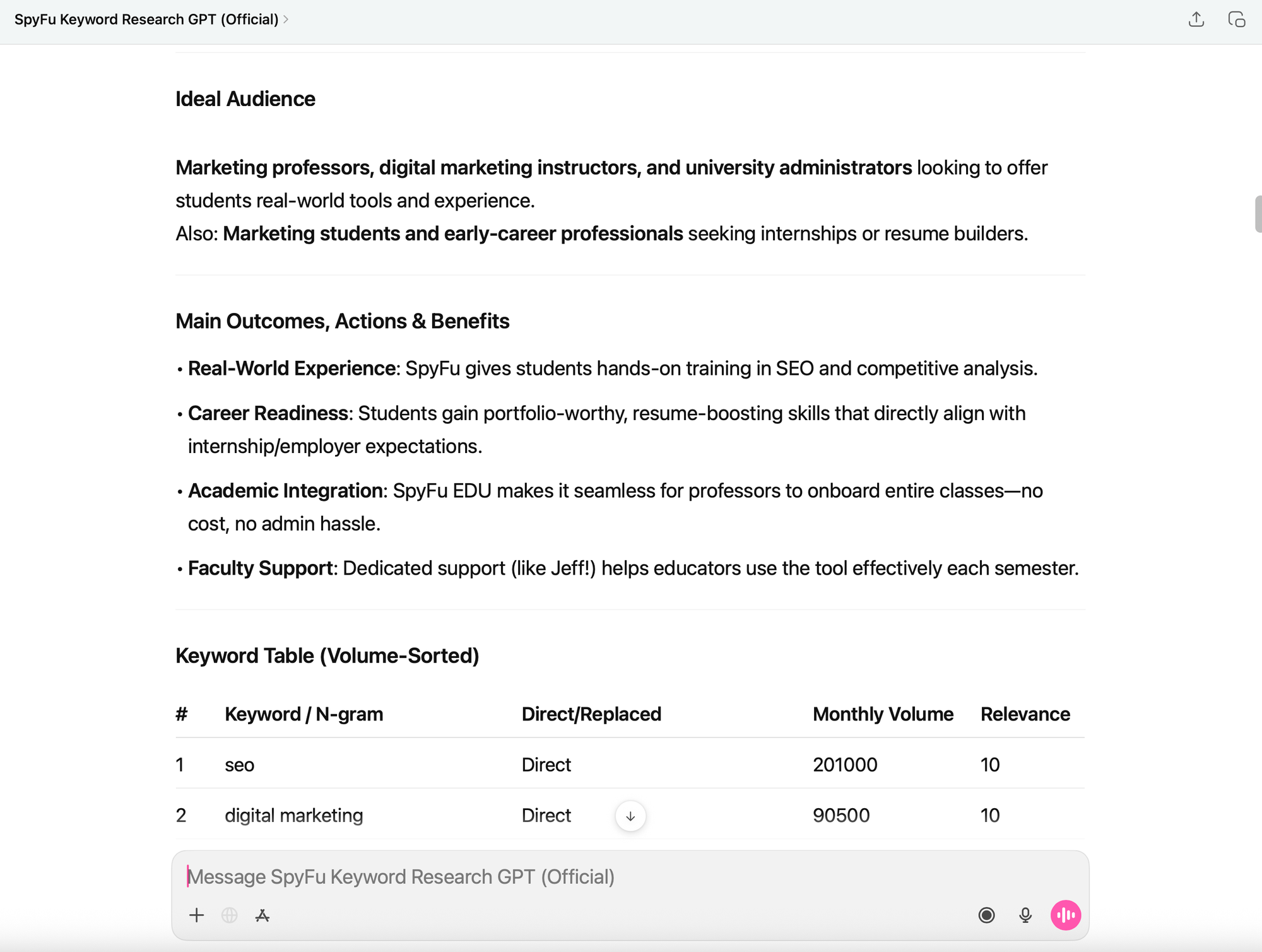Amanda was determined to find a better way, even if she had to invent it herself.
See, writing social captions sounds quick and easy—until you’re trying to make each one searchable, on-brand, and backed by keyword data.
And all of us, social media creator or not, have been captivated by one "there has to be a better way" idea.
Amanda Wright is SpyFu and RivalFlow's community manager and social media content creator. She wanted a faster way to write keyword-optimized captions for short-form videos.
"Writing captions that used the actual words people search took up too much of my time. I’d guess at keywords, look them up in SpyFu, then rewrite—too much friction for one short video.”
Kick your ideas out of the "stalled" stage
I'll give you the full scoop up front. Amanda learned she could stream SpyFu data in ChatGPT to build a custom tool for her captions. At the time, this was a proof of concept. But now, we're making ideas like hers possible for every SpyFu customer.
Any data-backed project that ever seemed too audacious, too complex, or just too time-consuming is now within reach with SpyFu's ChatGPT integration.
Let's see how Amanda turned that into a visibility-boosting, time-saving social media tool.
Writing Smart Captions Was a "Whole Thing"
Social captions are short, but that doesn't make them throwaway copy. A good social media caption is clear, brief, and on-topic enough to land in a search--all while being relatable. One more thing Amanda aims for is to be mindful of SEO practices and consistent brand phrasing.
To do all that, Amanda found herself manually checking keywords in SpyFu, tweaking her captions to include higher-volume phrases, and still second-guessing whether her posts were discoverable.
She needed a faster way to connect real search data with short-form content. So she asked: “Can we automate this with SpyFu data?”
Spoiler alert: We could.
Turning a Pain Point into a Prompt
What happened next relied on inside access to a project that--at the time--was still under wraps. Amanda knew that she could access SpyFu data through the website, but she wanted to automate her steps. That sounds like a ChatGPT job, but ChatGPT is notoriously bad at making up keyword data that it doesn't have.
(Really, embarrassingly bad.)
That's when Amanda learned some great news at just the right time. SpyFu had a custom integration with ChatGPT.
She could automate multiple steps to deliver optimized captions. And yes, she could trust the data it used to get there.
SpyFu + ChatGPT = reliable keyword-based tasks at lightning speed

Amanda dove into the SpyFu GPT tool and started building a prompt that did three key things:
- Pulled real keyword data using SpyFu’s search volume.
- Suggested better keyword variants based on that data.
- Spit out a caption that could perform better in platform search.
Amanda's prompts generated SEO-focused captions in seconds—and it worked off transcripts and minimal context, which meant we could apply it across our whole content pipeline.
This project was one of the first times we combined ChatGPT with SpyFu data to solve a real-world marketing task.
Instagram Posts are now Indexed in Google SERPs
Just one day later, this announcement from Instagram made Amanda's work even more meaningful:
Public posts from business and creator accounts could now appear in Google Search results.
That was exactly what Amanda had optimized for. Intentional or not, her captions wouldn’t just help with Instagram’s in-app search. They could show up in Google results, too.
Our social media content just picked up some SEO oomph.
Optimizing for Google via Automation
That news sparked more inspiration. How could she optimize even further for Google visibility? Amanda dug into lessons we could pull from what's working now.
Analyzing Instagram posts that were already ranking in Google searches, Amanda used some reverse engineering to learn how to structure Instagram captions going forward:
"I noticed a pattern where top-ranked Instagram posts or reels led with the target keyword in the first line."
Hashtags help, and descriptive alt text goes a long way.
Then Amanda ramped up the automation.
"I learned I could drop a given Instagram Reel URL into SpyFu to check whether it appears for any keywords. I asked ChatGPT to pull those from our public @RivalFlowAI account—including captions and alt text—so I could analyze them in bulk.
Later, I scoped ways to track clicks/keywords at the individual‑post level—essentially treating Instagram posts like mini landing pages."
Now, if you're keeping score, so far Amanda has automated:
- Reviewing captions from Instagram reels
- Comparing search volume on topical keywords in the caption
- Suggest higher search-volume keywords in caption form
- Capture all permalink URLs from our brand's Instagram page
- Pull captions and alt text from social posts for analysis
- Measure clicks and keywords from our Instagram posts' SERP rankings
With that reverse engineering, she was able to add new priorities into her SpyFu + ChatGPT prompts that streamlined her work ever more.
The output would follow this pattern:
- Front-loading high-volume keywords into the first line
- Writing keyword-optimized alt text
- Structuring hashtags to serve both Instagram and Google intent
She also started using SpyFu to monitor which Instagram URLs (like individual Reels) actually showed up in search and which keywords triggered them.

Optimizing the Instagram Profile Itself
Amanda took this opportunity to make other updates to our Instagram profile to help lift its visibility. She updated the bio to include keyword‑rich language, and just like with captions, it puts the targeted keywords up front. (AI SEO content optimizer built by SpyFu. Fix and optimize content to rank in Google and show up in ChatGPT. #RivalFlowAI).
Social SEO Best Practices
Since Amanda focused on getting future posts to appear on the SERPs, she made new guide posts for herself.
- Link to priority reels/posts from crawlable pages (blog posts, resource pages) to help search engines revisit them
- Tag outbound links with UTM parameters to attribute referral traffic.
An Idea She Could Act On
After a bit of brainstorming with team members and ChatGPT, Amanda created a SpyFu data-powered caption creator by giving instructions to ChatGPT with the entire SpyFu API to pull from.

The simplicity of getting SpyFu data inside ChatGPT gave her a chance to fast-track a tool that she otherwise didn't have the resources to create.
We love to see it.
Making "What Ifs" Possible & Actionable
This all started with a caption that took too long to write. Amanda's usual process meant guessing at keywords, checking them in SpyFu, rewriting captions, and still wondering if they’d be discoverable.
Now we’ve got a system that helps make Instagram content more discoverable—inside the app and across Google Search. The timing may have been lucky, but the results are built on strategy.
While Amanda did some early research to find best practices, the real breakthrough came from automating that process using SpyFu GPT.
With a custom ChatGPT integration, SpyFu puts ideas like this within reach. SpyFu data captures competitor rankings, popularity of searches, website traffic and so many SERP-based features that you can imagine. All of that is backed by a database with more keyword data than Ahrefs or Semrush, giving you a truer picture of what's happening with a website.
Want to create a data-backed solution for yourself? Ask SpyFu GPT to help you get started.

